The Genuine Progress Indicator (GPI) provides citizens and policymakers insight into how our environment, society, and economy affect the well-being of people. The GPI is designed to measure sustainable economic welfare rather than just economic activity. To accomplish this, the GPI uses three simple underlying principles for its methodology:
- account for income inequality
- include non-market benefits from the economy, environment, and society that are not included in Gross Domestic Product (GDP) and
- identify and deduct costs such as environmental degradation, human health effects, and loss of leisure time.
The GPI developers identify indicators relevant to these principles then populate them with verifiable data. As one example, the pure economic activity stemming from the explosive growth of urban sprawl contributes greatly to the GDP. Yet, along with sprawl come non-economic costs such as increased commuting time, land use conversion, along with water and air pollution. In short, just because we are exchanging money within an economy does not necessarily mean that we are sustainable or prosperous.
While it has long been realized that GDP is an insufficient measure of wellbeing; even its creator, Simon Kuznets, stated that “The welfare of a nation can scarcely be inferred from a measurement of national income” in 1934. However, that has not prevented GDP’s primacy as the measure of progress. The first effort to improve upon GDP as a measure of progress occurred in 1972, when American economists William Nordhaus and Nobel Prize winner James Tobin developed the Measured Economic Welfare (MEW). Ecological economist Herman Daly (professor emeritus at the University of Maryland, College Park) and theologian John Cobb picked up their work nearly two decades later as they investigated how to develop a macro measure of welfare by creating the Index of Sustainable Economic Welfare (ISEW). The public policy think tank Redefining Progress built upon the work by Daly and Cobb and created the GPI in 1995 and has since been calculated for many countries and states by academics. Maryland became the first U.S. state to formally calculate and maintain GPI accounts in 2010. Other states, like Vermont, Hawaii, Minnesota, and Washington, have since begun tracking their GPI but Maryland is currently the only state which updates the GPI annually.
Maryland Quality of Life Initiative
The Maryland Quality of Life Initiative is a partnership between Maryland businesses, non-profits, academics, and the state with the goal to characterize quality of life in the state and identify ways to improve it. The Maryland Genuine Progress Indicator was identified as a resource to indicate quality of life and a first step in building a “Quality of Life Dashboard” for the state. The initiative held a summit in 2015 bringing together 150 different organizations to address needs for enhancing quality of life in Maryland. Maryland Non-Profits (a “non-profit for non-profits” which helps to organize and advocate for non-profit organizations in Maryland) is the organizing body for the Quality of Life Initiative, and holds an annual Maryland Quality of Life Address, to highlight the state of quality of life in Maryland and current legislative initiatives relevant to the improving quality of life.
Evolution of the GPI Methodology
When the GPI was originally formulated it collected 26 indicators broken in to economic, environmental, and social categories. As our understanding of the costs and benefits of economic activity has grown and better data has become available practitioners recognized the need to update the original methods. The “GPI 2.0” accomplishes this by taking advantage of the increasing availability of data and the most recent scientific understanding of factors influencing our well-being. As an example of the increasing resolution of data available, the amount of money people spend on items in their daily lives was inferred from national data and considered together in GPI 1.0, whereas in 2.0 we were able to consider data gathered for household spending in Maryland broken into 17 categories. This helps us make the determination of what expenditures are contributing to well-being at a finer scale. Recent scientific literature has helped us improve the determination of several indicators, including the cost of inequality, value of ecosystem services, the cost of air pollution, and the cost of noise pollution. We are using spatial data to calculate some indicators, like the extent of forest in Maryland and the cost of air pollution. GPI 2.0 has 12 categories, with 50 indicators spread across them.
The drawback to relying on recently available data is that it often does not extend very far into the past. For this reason, we are only able to present 2012 through 2019 calculated using the GPI 2.0 methodology. Unfortunately very little data is currently available for 2020, likely at least partially due to the COVID-19 pandemic. We maintain the GPI 1.0 results on this website, which extends from 1960 to 2013.
GPI 2.0
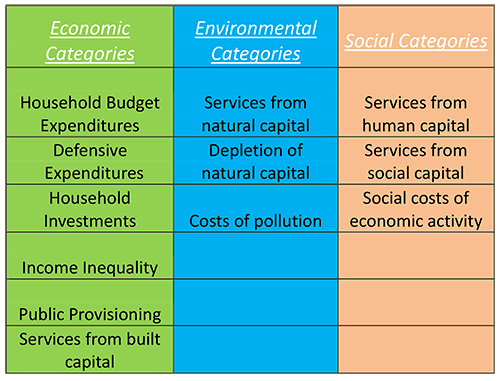
Highlights from 2012-2019
Over the entire period of record the GPI has fallen by $14.41 billion dollars, a 7% decrease. Significant factors in this decrease include falling overall household budget expenditures (decreased by $9.5 billion), a large increase the defensive expenditures category, predominantly from increases in insurance and medical care costs ($8 billion), a $5 billion (20%) increase in the cost of income inequality, a $3 billion increase in the cost of commuting and a $2 billion increase in the costs of crime when comparing 2012 to 2019. There were several categories that saw significant improvements over this time period; the cost of underemployment fell by nearly $4 billion, cost of pollution declined by 13% ($0.77 billion) and higher education increased by $7 billion. Marylanders had more leisure time and did more unpaid labor, with these factors increasing by 6.5 and 12%, respectively. We also have seen a decrease in the cost of homlessness of nearly 14% over this time.
There is significant variability within the GPI over the 2012 to 2019 period (see graph below), with the largest percent decrease occurring in 2014 where it fell 10% from the previous year. This is largely due to a commensurate decrease in household budget expenditures for that year. The yearly estimates of household budget expenditures is the single largest influence on the overall GPI. The 8 year trend we observe in the GPI is in contrast to the trend observed in Maryland’s Gross State Product (GSP) over the same time period, where it has grown by ~10%.
Highlights from 2018-2019
The GPI increased by $7 billion (4%) from 2018 to 2019. The increase in the GPI was driven by increases in household budget expenditures ($3.6 billion), and a decline in the costs of income inequality ($4 billion) and underemployment ($0.79 billion) from the prior year. We did see increases in the loss of natural lands ($0.15 billion, a 10% increase) and depletion of nonrenewable energy resources ($0.29 billion, a 7% increase). Interestingly, in this case Maryland GSP aligns well with the GPI as it also increased by nearly 4% from 2018 to 2019.
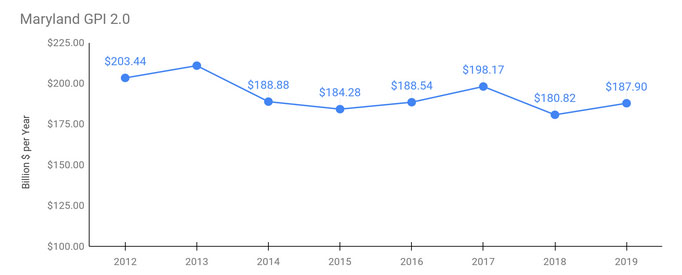
Maryland GPI
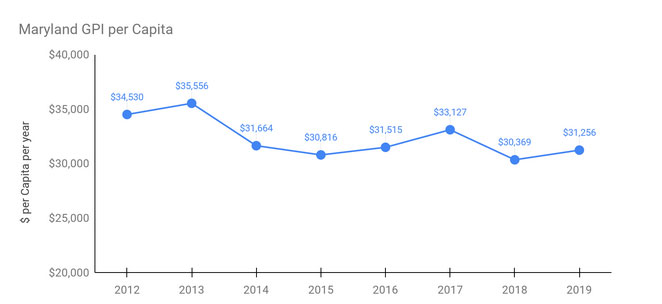
GPI Per Capita
The GPI per capita in Baltimore was taken from the report by the Center for a Sustainable Economy, Economic Well-Being in Baltimore Report.
GPI 1.0
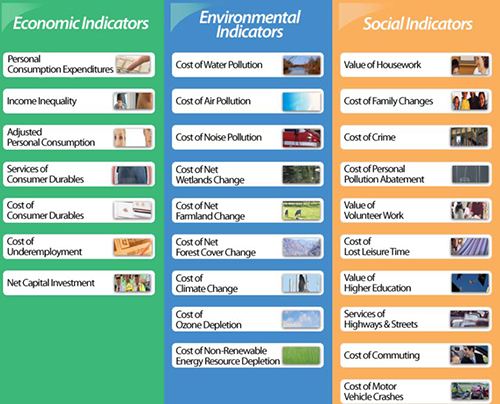
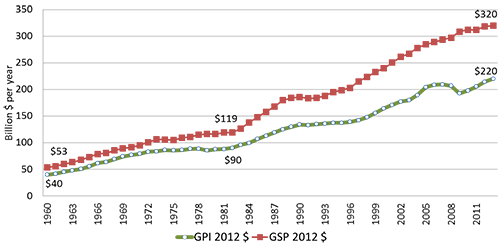
Looking at the past 50 years of data it can be observed that while the GPI has increased, it has failed to keep pace with the increase in the Gross State Product of Maryland. This is attributable to increases in income inequality, loss of natural lands, the costs of climate change and use of non-renewable resources.